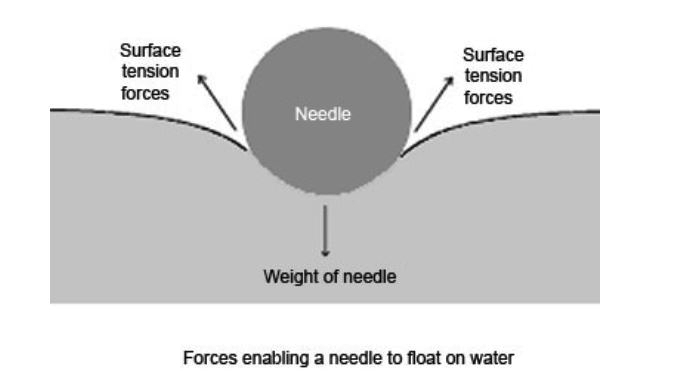- Definition of Force
- Effects of force
- Types of Forces
- Mass and Weight
- Measuring Force
- Scalar and Vector Quantities

Definition of Force
Force is a pull or a push on a body. Its SI unit is newtons (N)

Effects of force
- It can increase the speed of a moving object or make a stationary object start moving.
- Slow down or stop a moving object.
- Change the direction of a moving object.
- Distort (change) the shape of an object.
Force is that which changes a body’s state of motion or shape. Some forces are small and others are large.
Force is represented by a line with an arrow showing the direction it acts. i.e → F

Types of Forces
- Gravitational force
- Tensional
- Upthrust
- Frictional force
- Magnetic force
- Centripetal force
- Cohesive adhesive force
- Molecular force
- Electric force
- Nuclear force
- Electrostatic force
Gravitational force
Is a force of attraction between two bodies of given mass.
Objects thrown from the earth’s surface always falls back to the surface of the earth. This force which pulls the body towards the centre of the earth is called Gravitational force.
Moon and other planets also have their gravitational force to objects.
The pull of gravity on the body towards the centre is called weight. The weight of an object varies on different planets because of different gravitational pull.
Tension Force
Tension force is as a result of two opposing forces applied. The pull or compression of a string or spring at both of its ends is called Tension.
Compressed or stretched object will tend to regain its original shape, when the stretching or compressing force is removed. Materials that can be extended without breaking are called elastic materials. Such materials can be used to make a spring balance an instrument used to measure force. Other examples include; bows and catapults.
Upthrust Force
The upward force acting on an object immersed in a fluid (liquid or gas) is called upthrust force.
An object in a vacuum will not experience upthrust.
Example
An object weighs 80N in air and 60N when immersed in water. Calculate force acting on the object.
Solution
Upthrust force = weight of object in air –weight of object in the liquid
=80-60
=20N
Exercise
- An object weighs 100N in air and 26N when immersed in water. Calculate the apparent loss weight of the object. Calculate also the mass of object in water.(1Kg=10N).
- 2kg blue band weighs 20N when placed in air. The apparent loss in water is 2N. Calculate the mass of blue band in water.
Frictional Force
Frictional force is a force that opposes relative motion between two surfaces in contact.
The opposing force involving a fluid is called viscous drag (viscosity). This viscous drag limits the speed with which a body can move in a liquid.
Friction can be applied during walking.
EXPERIMENT: To investigate frictional force.
Apparatus: wooden block , rollers .
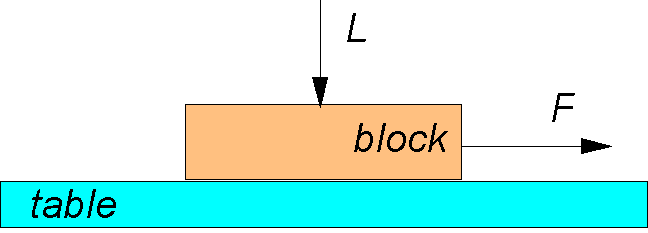
Pulling a block without rollers
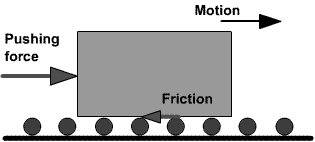
pulling a block with rollers
Procedure:
- Put a block of wood on a horizontal surface such as a bench as shown.
- Pull the block gradually, increasing the force.
- Repeat the experiment, this time resting on rollers as shown above
Conclusion
The wooden block starts to move when the applied force is just greater than frictional force between the block and the surface of the bench.
Frictional force can be reduced by using rollers, oiling and smoothening.
Magnetic Force
Magnetic force is the force of attraction or repulsion between a magnetic material and a magnet.
A magnet has two types of poles, a north pole and a south pole. Like poles repel while unlike poles attract. some materials are attracted by a magnet while others are not. Those that are attracted are called magnetic materials e.g iron ,steel ,nickel and cobalt while those that are not attracted are called non-magnetic materials e.g. wood and aluminium.
Cohesive and Adhesive Forces
The force of attraction between molecules of the same kind is known as cohesive force e.g. A water molecule and another water molecule.
The attraction between molecules of different kinds is known as adhesive force e.g. between water molecules and molecules of the container in which the liquid is put.
EXPERIMENT: To see the behaviour of water on different surfaces.
- Water wets glass
Observation
Water on the glass slide spreads - Water forms spherical water drops on waxed surface
Observation
Small spherical balls was observed on a waxed glass
EXPLANATION
Water wets the glass surface because the adhesive forces between the water molecules and the glass molecules are greater than the cohesive forces between water molecules.
Water does not wet the waxed glass surface because the cohesive force is greater than the adhesive.
If mercury was used in the experiment it could be observed that small drops on a clean glass dish collect into spherical ball as shown below
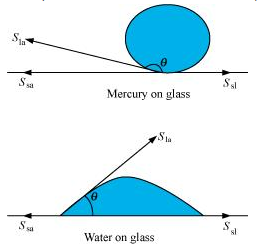
This is due stronger cohesive forces between mercury molecules which forms small spherical drops. The adhesive force between mercury and glass makes mercury not wet glass.
N/B: Mercury is poisonous and should not be handled in ordinary laboratory.
EXPERIMENT: to demonstrate cohesive and adhesive forces of liquids on narrow tubes
APPARATUS: narrow tubes of different size of bore, beaker and water
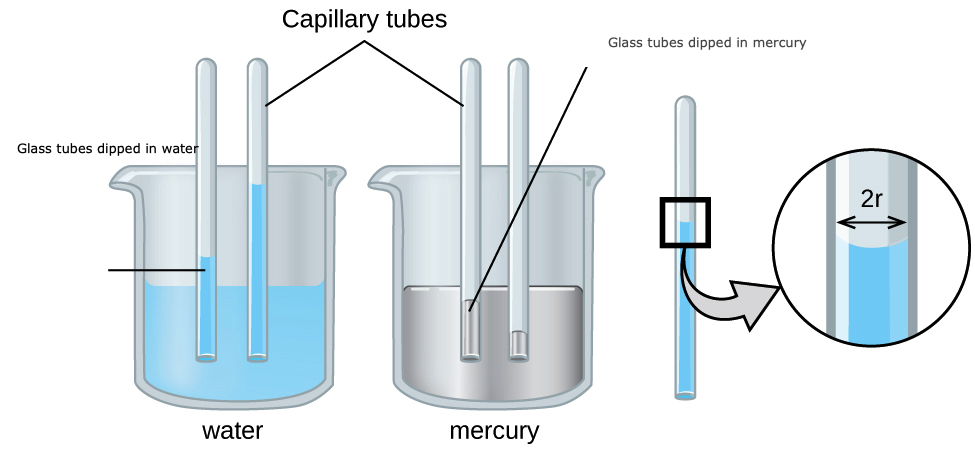
OBSERVATION
The level of the water inside the tubes is higher than outside the tubes. A meniscus is formed at the top of the water level and it curves upwards(concave).
The rise in the tube with a smaller bore is higher than in the tube with a larger bore.
Different liquids rise by different heights depending on the diameter of the glass tube.
When mercury is used, the level of mercury inside the tubes goes lower than that outside the tubes. The surface of the mercury will curve downwards (convex).
EXPLANATION
Adhesive forces between the water and glass is greater than cohesive forces between the water molecules, the water rises up the tube so that more water molecules can be in contact with the glass. This wets the glass. Liquids such as glycerol, kerosene and methylated spirit rise in tubes.
On the other hand, the force of cohesion with the mercury is greater than the force of adhesion between glass and mercury. The mercury sinks to enable mercury molecules to keep together.
Surface Tension
This is a force that causes the surface of a liquid to behave like a stretched plastic skin.
The force is due to the force of attraction between individual molecules in a liquid.
Its due to this force that liquids form drops, water wets the surface but runs off others, some insects like pond skaters manage to rest on the surface of water without sinking, water rises up in narrow glass tubes but mercury is pushed down to a lower level in the same tube and steel needle or razor blade floats on water even though steel is denser than water
EXPERIMENT: to investigate the behaviour of a liquid surface
APPARATUS: Beaker, water, soup solution, razor blade or steel needle.
PROCEDURE:
- Fill the beaker with clean water to the brim as shown
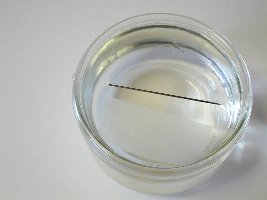
- Place a dry steel needle or razor blade at the edge of the beaker and carefully introduce it on the surface of water. Take care not to break the surface of water. Observe what happens.
- Put a few drops of soap solution and observe what happens.
- Depress the tip of the needle into the water and observe what happens.
- Put a few drops of soap solution and observe what happens.
- Depress the tip of the needle into the water and observe what happens.
OBSERVATIONS
- The razor blade/needle floats on the surface of water and remains resting so long as the water surface is not broken.
- When drops of soap solution are put on the surface of the water around the razor blade/steel needle, the razor blade/steel needle sinks after a few minutes.
- Depressing the razor blade highly allows it to sink very quickly
EXPLANATION
- The razor blade/needle floats because the surface of water behaves like a fully stretched, thin, elastic skin. The force which causes the surface of a liquid to behave like a stretched skin is called surface tension. This force is due to the force of attraction individual molecules of the liquid. (cohesive force)
- The needle or blade sinks when drops of soap solution are put near the razor/needle because the soap solution reduces surface tension of the water.
- When the tip of the needle or razor is depressed into the liquid, it pierces the surface skin and sinks.
Molecular Explanation of Surface Tension
A Molecule say C deep in the liquid is surrounded by molecules on all sides so that the net force in it is zero. However, molecules of the surface, say A and B will have fewer molecules on the vapour side and hence it will experience a resultant inward force causing the surface of the liquid to be in tension.
Factors Affecting Surface Tension
- Impurities – impurities reduces surface tension of a liquid. Detergents weaken the cohesive forces between the liquid molecules.
- Temperature – Increasing the temperature of a liquid increases kinetic theory of molecules. The inter-molecular distance increases and the force of cohesion is decreased hence surface tension is lowered..
Consequences/Effects of surface tension
- Water insects can rest on the surface of water without breaking the surface. The insects skate across the surface at high speed.
- Mosquito larvae float on water surface. Oiling the surface using kerosene lower surface tension making larvae to sink.
ASSIGNMENT (make notes)
- To Study the behaviour of soap bubbles
- To study the behaviour of soap film
- To examine the appearance of water drops coming out of a tube
Electrostatic Force
This is a type of force which causes attraction or repulsion between charges. Charges can be positive or negative. Like charges repel and unlike charges attract
EXAMPLES
- A plastic pen or ruler rubbed on a dry hair or fur picks up small pieces of paper lying on a table when it’s brought near them. (Charges are created on the pen and attract the pieces of paper). The same pen or ruler attracts a stream of water from a tap. The rubbing creates static charge.
- When a glass window is wiped with a dry cloth on a dry day, dust particles are attracted on it.
- When shoes are brushed, they tend to attract dust particles.
Question: Explain why when you remove cloth at night you observe sparks
Electric Force
It’s a force which acts on two conductors carrying electricity.
Action and Reaction
They are two equal forces but acting in opposite to each other.
When a block of wood is placed on a table, its weight acts on a table (action). It is pressed on the surface downwards. The reaction (opposite force) of the table acts on the block.
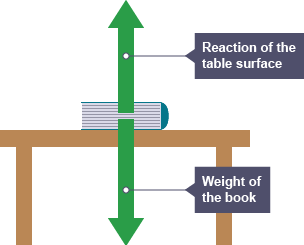
When one force acts on a body, an equal and opposite force acts on one another.
EXERCISE
| Work to be done | Type of force |
|
Separate a mixture of iron filings and sand |
Magnetic force |
| Fire a gun | Action and reaction |
| Cause tide in sea or ocean | |
| Absorb shock in vehicles | Electrostatics |
| Swim | |
| Water rising a narrow tube | Cohesive and adhesive |
| Toy boat on water surface | Surface tension |

Mass and Weight
Mass is the quantity of matter in an object while weight is a measure of the pull of gravity on an object. The S.I unit of mass is kg (kilogram) and of weight is Newton (N).
Mass of an object is a scalar quantity while weight is a vector quantity (since weight is a pull of gravity directed to the centre of the earth).
Due to the shape and rotation of the earth, the weight of an object varies from place to place while mass is constant (does not change).
A body weighs more at the poles than at the equator.
Differences between mass and weight
| Mass | Weight |
| Its a quantity of matter on a body. | It is a pull of gravity on a body |
| It’s measured in kg. | It is measured in (N) |
| Same everywhere |
Varies from one place to another. |
| Measured using a beam balance. | Measured using a spring balance |
| Has magnitude only (scalar quantity) |
Has both magnitude and direction.(vector quantity) |
Relationship between mass and weight
Weight =Mass x gravitational
W=mg
Example
- Find the weight of an object whose mass is 50 kg.
W=mg
50 x10 =500 N - Find the mass of an object whose weight is 900N
W =mg
900/10
M=90kg - An astronaut weighs 900N on earth .On the moon, he weighs 150 N. Calculate the moon’s gravitational strength. (g=10N/Kg)
M=w/g
=900/10
=90kg
On moon, w=mg
g=w/m
=150/90
=1.67N/Kg

Measuring Force
Force is measured using an instrument called a spring balance.
The extension of a spring can be used to measure an applied force. The larger the force, the more the spring extends.
A spring balance measures forces and should therefore calibrated in newtons.
Some spring balances are calibrated in kilograms. In such cases, one is advised to convert from kilograms to newtons. (1Kg=10N)
EXAMPLE
- The length of a spring is 16.0cm. Its length becomes 20.0cm when supporting a weight of 5.0N. calculate the length the length of the spring when supporting a weight of;
- 2.5N
- 6.0N
- 200N
Solution
- 5N = 4cm
2.5N- ?
(2.5 x 4)/5=2cm
2+16=18cm - 5N = 4cm
6N - ?
(6 x 4)/5 =4.8cm
4.8+16 = 20.8cm - 5N = 4cm
200N =?
(200 x 4)/5= 160
160+16 =176cm
Note; In c) extension is too large and spring may straighten out.

Scalar and Vector Quantities
Scalar Quantity
– is a quantity which has magnitude (size) only. It can be specified by a number and unit. Examples include; mass, area, density, volume, energy, time, pressure, temperature, and length.
Scalar quantities are added by the normal rules of arithmetic e.g. 3cm2+4cm2=7cm2
Vector Quantity
– is a quantity which has direction and magnitude (size). It can be specified by a number, unit and direction. Examples include; weight, force, velocity, displacement, acceleration, momentum and magnetic field strength.
A vector quantity is represented on a diagram by a straight line with an arrow.
The sum of two or more vectors is the resultant vector. Parallel forces can be added arithmetically which act on an object.
NOTE; Forces acting in opposite directions, the resultant is their difference.
To specify resultant force, both magnitude and direction are given.
Download FORCES - Form 1 Physics Notes.
Tap Here to Download for 50/-
Get on WhatsApp for 50/-
Why download?
- ✔ To read offline at any time.
- ✔ To Print at your convenience
- ✔ Share Easily with Friends / Students
